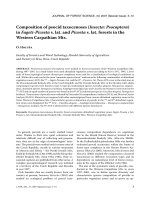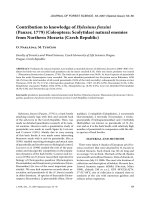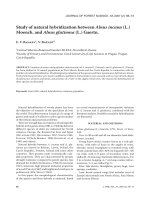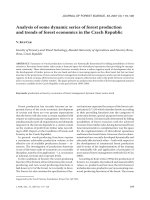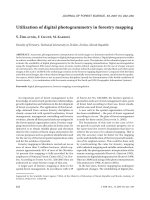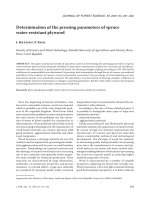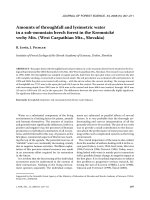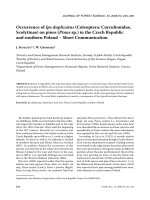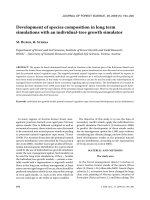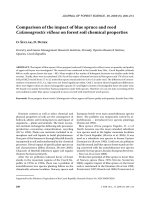Báo cáo lâm nghiệp: "Contribution of different solutes to the cell osmotic pressure in tap and lateral roots of maritime pine seedlings: effects of a potassium deficiency and of an all-macronutrient deficienc" pptx
Bạn đang xem bản rút gọn của tài liệu. Xem và tải ngay bản đầy đủ của tài liệu tại đây (1.13 MB, 13 trang )
Original
article
Contribution
of
different
solutes
to
the
cell
osmotic
pressure
in
tap
and
lateral
roots
of
maritime
pine
seedlings:
effects
of
a
potassium
deficiency
and
of
an
all-macronutrient
deficiency
Marie-Béatrice
Bogeat-Triboulot*
Gérard
Lévy
Équipe
sol
et
nutrition,
unité
d’écophysiologie
forestière,
Institut
national
de
la
recherche
agronomique
(Inra),
54280
Champenoux,
France
(received
7
April
1997;
accepted
4
September
1997)
Abstract -
Seedlings
of
maritime
pine
(Pinus
pinaster
Ait.)
were
grown
in
hydroponics
and
submitted
either
to
a
potassium
deficiency
or
to
an
all-macronutrient
deficiency.
In
response
to
both
nutrient
stresses,
tap
root
elongation
was
maintained
while
lateral
root
elongation
was
severely
reduced.
In
both
treatments,
K
content
was
decreased
to
0.85
%
of
dry
weight
in
roots
and
in
shoots.
Other
minerals
were
little
affected
by
the
single
deficiency
except
nitrogen,
whose
content
increased
significantly
in
roots.
Measurements
of the
concentrations
of
inorganic
ions,
sol-
uble
sugars
and
amino
acids
on
a
tissue
water
basis
revealed
that,
in
unstressed
plants,
potassium,
phosphate,
choride,
glucose,
fructose
and
glutamine
accounted
for
about
two
thirds
of
cell
osmotic
pressure
with
relative
contributions
depending
on
location
in
the
root
system.
In
seedlings
subjected
to
deficiency,
K
was
more
or
less
efficiently
replaced
by
soluble
sugars,
glutamine
and/or
sodium
according
to
location
in
the
root
system.
Osmotic
pressure
was
better
maintained
in
younger
tissues
but
also
in
tap
root
tip
as
compared
to
lateral
root
tip.
potassium
deficiency
/
osmotic
pressure
/
inorganic
ion
/
glutamine
/
soluble
sugar
/
root
growth
Résumé -
Contribution
de
différents
solutés
à
la
pression
osmotique
cellulaire
dans
le
pivot
et
les
racines
latérales
de
semis
de
pin
maritime.
Effets
d’une
carence
en
potassium
et
d’une
carence
en
tous
macroéléments.
Des
plantules
de
pin
maritime
(Pinus
pinaster
Ait.)
cultivées
en
hydroponie
ont
été
soumises
à
une
carence en
potassium
et
à
une
carence
en
tous
macroélé-
ments.
En
réponse
aux
deux
stress
nutritifs,
l’élongation
du
pivot
a
été
maintenue
alors
que
celle
des
racines
latérales
a
été
fortement
réduite.
Le
contenu
en
K
a
été réduit
à
0,85
%
du
poids
sec
dans
les
racines
et
les
parties
aériennes.
Les
autres
minéraux
ont
été
peu
affectés
par
la
mono-
carence
excepté
l’azote,
dont
la
teneur
a
augmenté
significativement
dans
les
racines.
La
mesure
*
Correspondence
and
reprints
E-mail:
des
concentrations
en
ions
inorganiques,
sucres
solubles
et
acides
aminés
(par
rapport
à
la
teneur
en
eau)
a
montré
que,
chez
les
témoins,
les
solutés
potassium, phosphate,
chlorure,
glucose,
fructose
et
glutamine
représentaient
environ
deux
tiers
de
la
pression
osmotique
cellulaire.
Cependant, la
contribution
de
ces
éléments
variait
d’un
endroit
à
l’autre
du
système
racinaire.
Dans
les
plantules
carencées,
le
potassium
a
été
plus
ou
moins
efficacement
remplacé
par
les
sucres
solubles, la
glutamine
et/ou
le
sodium
en
fonction
de
la
position
dans
le
système
racinaire.
La
pres-
sion
osmotique
a
été
mieux
maintenue
dans
les
tissus
jeunes
mais
aussi
dans
l’apex
du
pivot
par
rapport
à
l’apex
des
racines
latérales.
carence
en
potassium
/
pression
osmotique
/
ion
inorganique
/
glutamine
/
sucre
soluble
/
croissance
racinaire
Abbreviations:
Solute
charges
were
not
expressed
in
the
text
or
in
figures
and
tables:
K,
Na,
Mg,
Ca,
Cl,
PO
4
and
SO
4
were
used
instead
of
K+,
Na
+,
Mg2+
,
Ca2+
,
Cl
-,
(PO
4
3-
,
HPO
4
2-
,
H2PO
4-)
and
SO
4
2-
.
Moreover,
[K]
was
written
instead
of
’potassium
concentra-
tion’
and
similarly
for
other
solutes.
K,
potassium;
MD,
all-macronutrient
defi-
ciency;
KD,
potassium
deficiency;
TR,
tap
root;
LR,
lateral
roots;
TRA,
tap
root
apex;
TRPA,
tap
root
post-apex;
LRA,
lateral
root
apices;
LRPA,
lateral
root
post-apices;
P,
tur-
gor
pressure;
π,
osmotic
pressure;
PAR,
pho-
tosynthetically
active
radiation.
1.
INTRODUCTION
Potassium
(K)
is
the
most
abundant
cation
in
plant
tissues
and
plays
both
bio-
chemical
and
biophysical
roles
in
cells.
In
the
cytoplasm, although
it
is
not
part
of
the
structure
of
any
plant
molecule,
it
is
required
for
the
activation
of
several
enzymes,
for
protein
synthesis
and
pho-
tosynthesis.
It
also
plays
an
important
role
in
the
vacuole
where
it
contributes
largely
to
the
osmotic
pressure
and
thus
to
the
tur-
gor
pressure
[11,
13;
and
references
therein].
K
deficiency
may
occur
in
trees
growing
on
peaty
or
sandy
soils
[5,
20].
It
has
also
been
shown
that,
in
nurseries,
K
deficiency,
aggravated
by
an
excess
of
nitrogen
fertilization,
caused
injuries
to
Picea
pungens
glauca
[2].
The
most
important
consequences
of
K
shortage
are
a
higher
sensitivity
to
frost
damage,
lower
osmotic
adjustment
capac-
ity
during
drought
and
reduced
growth
rate
[13].
In
contrast
to
nitrogen
or
phos-
phorus
deficiencies,
K
deficiency
induces
a
decrease
of
the
root/shoot
biomass
ratio,
which
is
due
to
a
stronger
reduction
of
root
expansion
[6].
A
recent
study
con-
ducted
on
maritime
pine
seedlings
showed
that
a
potassium
deficiency
(KD)
affected
differently
the
elongation
of
the
different
types
of
roots
[23].
The
elongation
rate
of
the
tap
root
(TR)
was
not
affected
while
that
of
lateral
roots
(LR)
was
severely
reduced.
Furthermore,
the
effects
on
osmotic
and
turgor
pressures
(π
and
P)
varied
with
location
in
the
root
system.
In
particular,
π
was
significantly
reduced
in
the
mature
cells
next
to
the
expanding
zone
of
LR
but
not
of TR.
This
suggested
heterogeneous
capacities
of
the
root
sys-
tem
to
maintain
π.
These
differences
high-
light
the
variability
of
behaviour
existing
within
a
root
system,
even
at
an
early
stage
of
development.
Several
studies
have
already
shown
that
responses
varied
with
the
stimulus
and
with
the
type
of
roots.
For
instance,
growth
of
LR
of
cotton
seedlings
was
more
inhibited
by
salinity
than
was
primary
root
growth
[19].
TR
growth
of
Phaseolus
remained
almost
con-
stant
during
the
night
(as
compared
to
the
day)
while
LR
growth
was
reduced
[27].
On
the
other
hand,
temperature
inhibited
TR
growth
of
soybean
seedlings
but
did
not
affect
LR
growth
[22].
In
a
recent
study
the
osmotically
active
solutes
in
the
maize
root
tip
were
mapped
[17].
How-
ever,
little
information
is
available
about
their
distribution
in
various
parts
of
the
root
system.
The
aims
of
the
present
investigation
were
to
answer
several
questions
raised
by
the
different
growth
and
water
relation
responses
of
pine
roots
to
a
K
deficiency
[23].
i)
What
are
the
osmotically
active
compounds
in
pine
root
tissues?
ii)
Are
their
respective
contributions
to
the
osmotic
pressure
similar
everywhere
in
the
root
system?
iii)
What
are
the
effects
of
a
potassium
deficiency
on
the
distribution
of
the
solutes
in
the
different
parts
of
the
root
system?
iv)
Which
solute(s)
replace
potassium?
Seedlings
of
Pinus
pinaster
Ait.
were
grown
in
conditions
similar
to
those
in
our
previous
work
[23]
and
concentrations of
inorganic
ions,
soluble
sugars
and
amino
acids
were
determined
on
a
water
basis
in
different
parts
of
the
root
system
and
related
to
cell
osmotic
pressure.
More-
over,
the
potassium
deficiency
was
com-
pared
with
an
all-macronutrient
deficiency.
In
order
to
compare
their
effects
with
other
data,
the
mineral
contents
of
the
seedlings
in
above-
and
below-ground
parts
were
also
determined
on
a
dry
matter
basis.
2.
MATERIAL
AND
METHODS
2.1.
Plant
material
and
growth
conditions
Pinus pinaster
Ait.
seeds
(provenance
’Lan-
des’,
southwestern
France)
were
grown
in
hydroponics
as
described
previously
[23].
The
composition
of
the
control
nutrient
solution
was:
CaCl
2
0.5
mM,
MgSO
4
0.5
mM,
KH
2
PO
4
1
mM,
NH
4
NO
3
4
mM
and
micronutrients
[21]
In
the
growth
chamber,
temperature
was
22/19
°C,
humidity
70/90
%
(day/night),
pho-
toperiod
was
16
h
and
the
PAR
was
500-600
μmol
m
-2
s
-1
.
The
nutrient
solution
was
changed
once
a
week
and
pH
was
adjusted
daily
to
4.5-5.0
with
NH
4
OH.
Seedlings
were
subjected
to
two
different
mineral
constraints.
The
first
was
a
reduction
of
the
K
supply
to
1/40th
of
the
control
level.
In
the
nutrient
solution,
1 mM
KH
2
PO
4
was
replaced
with
[1
mM
(NH
4
)H
2
PO
4
+
25
μM
KH
2
PO
4]
and
NH
4
NO
3
supply
was
reduced
from
4
to
3
mM
in
order
to
keep
the
NH
4+
con-
centration
at
the
level
of
controls.
This
treat-
ment
is
referred
to
as
KD.
The
second
con-
straint
consisted
of
a
deficiency
of
all
macronutrients
(referred
to
as
MD).
Supplies
of
Ca,
Cl,
Mg,
S,
K,
P
and
N
were
reduced
to
1/40th
of
the
control
levels.
2.2.
Harvest
Seedlings
were
harvested
30
days
after
ger-
mination.
Lengths
of
the
shoots
(consisting
only
of
a
bunch
of
primary
leaves),
of
the
tap
root
(TR)
and
of
the
three
longest
lateral
roots
(LR;
as
an
assessment
of
the
length
of
the
lat-
eral
roots)
of
each
plant
were
measured
just
before
harvest.
After
these
measurements,
plant
root
systems
were
rinsed
by
a
rapid
immersion
in
deionized
water
and
quickly
blotted
dry.
To
determine
the
mineral
content
as a
frac-
tion
of
dry
weight,
the
whole
root
system
and
primary
leaves
were
separated
and
dried
at
60 °C
for
48
h.
To
determine
solute
concen-
trations
on
a
water
basis,
several
parts
of
the
root
systems
were
collected:
a)
the
apical
15
mm
of
the
TR
tip,
referred
to
as
TR
apex
(TRA);
b)
the
following
30
mm
of
the
TR,
referred
to
as
TR
post-apex
(TRPA);
c)
the
apical
10
mm
of
the
LR,
referred
to
as
LR
apex
(LRA);
and
d)
the
remaining
part
of
the
LR,
referred
to
as
LR
post-apex
(LRPA).
For
the
KD
stressed
plants,
no
part
d)
could
be
col-
lected
since
LR
were
usually
shorter
than
10
mm.
Anatomical
observations
showed
that
parts
a)
and
c)
contained
the
expanding
tissues
but
also
some
mature
tissues
[23].
The
tissue
samples
were
placed
either
in
insulin-type
syringes
(for
the
inorganic
ion
analysis)
or
in
1.5
mL
microtubes
(for
the
sol-
uble
sugar
and
amino
acid
analysis),
immedi-
ately
frozen
in
liquid
nitrogen
and
stored
at
- 20 °C
until
analysis.
Corresponding
tissue
samples
of
three
to
four
plants
were
pooled
in
a
single
syringe
(or
microtube)
in
order
to
obtain
enough
material
to
carry
out
the
analy-
sis.
Analyses
were
conducted
on
samples
of
35-150
mg
(15
mm
of TR
corresponded
to
about
12
mg
fresh
weight).
All
lateral
roots
of
one
plant
were
pooled
together
or
split
into
two
samples.
In
order
to
increase
the
number
of
samples,
the
whole
experiment
was
replicated
twice.
No
differences
appeared
between
the
two
repli-
cates
and
therefore
data
were
pooled
together.
In
total,
56,
58
and
42
seedlings
were
used
for
the
control,
KD
and
MD
treatments,
respec-
tively.
2.3.
Mineral
content
as
fraction
of
dry
weight
Dry
samples
were
ground
to
powder
in
liquid
nitrogen.
An
aliquot
of
each
sample
(5
mg)
was
used
to
measure
the
total
nitrogen
content
with
a
C.H.N.
(Carlo
Erba
Instru-
ments).
Following
the
combustion
of
the
sam-
ple
at
950 °C,
nitrogen
oxides
were
reduced
to
N2
and
this
gas
was
detected
by
a
thermal
conductivity
detector.
To
determine
K,
Na,
Mg,
Ca
and
P
contents,
20
mg
of
each
sample
were
dry-ashed
at
500 °C and
ashes
dissolved
in
5
mL
HCl
I N.
Concentrations
of S,
P,
Mg,
Ca,
Na
and
K
were
determined
with
a
sequen-
tial
ICP-OES
(JY
38+,
Jobin
Yvon,
Longjumeau,
France)
and
expressed
relative
to
dry
weight
(g
g
-1
DW).
Because
of
the
small
volume
of
samples,
we
used
the
’direct-pick-
ing’
method
with
three
replicates
for
each
ele-
ment.
2.4.
Solute
analysis
in
tissue
extracts
2.4.1.
Inorganic
ion
analysis
Insulin-type
syringes
(with
a
very
small
dead
volume)
were
used
to
extract
tissue
sap.
Glasswool,
previously
cleaned
with
HCl
1N,
rinsed
with
ultra-pure
water
and
dried,
was
placed
at
the
bottom
of
each
syringe.
Severed
tissue
was
inserted
into
the
syringe
tube
and
the
piston
put
back
into
it.
After
thawing,
tissue
sap
was
collected
by
pushing
the
piston
back
and
diluted
with
ultra-pure
water
about
100
times
(determined
by
weighing).
This
brought
ion
concentrations
into
the
range
of
the
best
accuracy
of
the
methods
of
analysis.
Concentrations
of
K,
Na,
Mg,
Ca
and
P
were
then
measured
with
ICP-OES
as
described
above,
and
of Cl
-,
NO
3-,
PO
4
3-
and
SO
4
2-
with
ionic
chromatography
with
a
con-
ductimetric
detection
and
an
autosuppression
recycle
mode
(Dionex
DX
300,
Sunnyvale,
USA).
This
was
associated
with
an
automatic
injector
(Gilson
222
XL,
Villiers
le
Bel,
France).
Guard
column
AG12A
and
column
AS
12A
were
used
with
an
(Na
2
CO
3
2.7
mM
/
NaHCO
3
0.3
mM)
eluant
and
a
flow
rate
of
1.5
mL
min
-1
.
Injection
volume
was
50
μL.
We
noticed
that
P
concentrations
measured
by
inductively
coupled
plasma
were
correlated
with
the
PO
4
3-
concentrations
measured
by
ionic
chromatography
over
the
whole
range
of
concentrations
([P04
3-
]
=
1.02[P] -
2.24,
r2
=
0.94,
data
not
shown).
A
similar
correlation
was
observed
between
S and
SO
4
2-
,
indicat-
ing
that
soluble
P
and
S
in
the
tissue
extracts
were
present
in
inorganic
form.
2.4.2.
Soluble
sugar
analyses
Frozen
tissues
were
crushed
in
a
tube
con-
taining
0.5
mL
of
80
%
ethanol
at
80 °C.
These
conditions
neutralized
invertase
before
it
could
decompose
sucrose
into
fructose
and
glucose.
Microtubes
were
rinsed
with
0.5
mL
80
%
ethanol.
After
30
min
extraction,
supernatants
were
collected
and
residues
rinsed
twice
with
0.5
mL
80 %
ethanol.
After
drying,
the
extracts
were
dissolved
in
1 mL
ultrapure
water,
puri-
fied
with
micro-columns
filled
with
ion-
exchange
resins
(0.5
mL
cationic
resin,
Amber-
lite,
IRN77,
Prolabo;
0.5
mL
anionic
resin,
Ag1×8,
formate,
Biorad)
and
dried
again.
Before
analysis,
the
extracts
were
dissolved
in
400
μL
ultra-pure
water
and
filtered
(0.45
p,
Acrodisc,
Gelman).
Next
20-40
μL
were
injected
in
a
HPLC
equipped
with
a
Poly-
sphere
Pb
column
(Merck)
and
ultrapure
water
as
eluant.
2.4.3.
Amino-acid
analysis
Extraction
was
carried
out
at
4
°C.
40
μL
of
an
internal
standard
(α-butyric
acid)
were
added
to
samples
which
were
crushed
with
a
pinch
of
pure
quartz
sand
in
150-300
μL
of
70 %
methanol.
After
a
15-min
incubation,
microtubes
were
centrifuged
for
10
min
at
14 000
r/min.
Supernatants
were
collected
and
the
residues
rinsed
with
150
μL
70 %
methanol.
The
extracts
were
filtered
(0.45
μm)
and,
90
s
before
the
injection
in
HPLC,
10
μL
ortoph-
taldialdehyd
(OPA)
were
added
to
40
μL
sam-
ple.
The
fluorescent
derivatives
of
the
amino
acids
were
detected
at
340
nm.
The
HPLC
was
fitted
with
a
RP18
column
and
a
(20 %
methanol-80 %
sodium
acetate)-100 %
methanol
gradient
was
used
as
eluant.
2.5.
Calculation
of
the
cellular
concentration
of
the
solutes
In
a
side
experiment
on
unstressed
plants,
we
measured
the
osmotic
pressure
of
single
cells
of
the
different
parts
of
the
root
(TRA,
TRPA
and
LRA)
with
a
cryoscopic
picolitre
osmometer
[12]
and
the
osmotic
pressure
of
the
sap
of
these
tissue
parts
with
a
vapour
pres-
sure
osmometer
(Wescor
5500).
The
ratio
between
cell
osmotic
pressure
and
tissue
sap
osmotic
pressure
yielded
a
coefficient
corre-
sponding
to
the
dilution
of
cell
sap
by
apoplas-
mic
sap
or
by
water
remaining
on
the
surface
of
the
roots.
The
dilution
coefficients
were
1.15,
1.28
and
1.75
for
TRA,
TRPA
and
LRA,
respectively.
The
large
dilution
coefficient
for
LRA
was
probably
due
to
the
drying
technique
used
for
these
sections
(several
roots
dry-blot-
ted
together,
in
order
to
limit
root
dehydration
before
storage).
The
coefficient
determined
for
LRA
was
also
used
for
LRPA
sections.
Cellular
solute
concentrations
were
calcu-
lated
by
multiplying
the
concentrations
mea-
sured
in
tissue
sap
by
the
dilution
coefficient
of
the
corresponding
root
section.
In
order
to
cal-
culate
the
contribution
of
each
solute
to
the
cell
osmotic
pressures
(π),
these
concentra-
tions
were
related
to
π measured
in
the
corre-
sponding
tissue
sections
in
plants
grown
in
same
conditions
as
described
above
[23].
Cell
π
was
measured
by
cryoscopy
and
converted
from
MPa
to
osmol
L
-1
using
the
Van
t’Hoff
relation
[9].
When
calculating
the
contribu-
tions
of
solutes
to
cell π,
we
neglected
the
osmotic
coefficients
and
thus
obtained
semi-
quantitative
contributions
of
solutes
to
π.
3. RESULTS
3.1.
Effect
of
deficiencies
on
growth
and
mineral
content
The
potassium
deficiency
(KD)
did
not
affect
tap
root
(TR)
elongation
but
reduced
significantly
lateral
roots
(LR)
elongation
of
the
maritime
pine
seedlings
(figure
1B
and
C),
as
found
in
our
previous
experi-
ment
[23].
Moreover,
growth
of
shoots,
displaying
only
a
bunch
of
primary
leaves,
was
significantly
decreased
(figure
1A)
and
symptoms
of
K
deficiency,
such
as
yellowing
and
necrotic
rings,
appeared
on
needles.
As
compared
to
KD,
the
all-
macronutrient
deficiency
(MD)
inhibited
LR
elongation
less
and
shoot
growth
more
but
did
not
induce
any
deficiency
symp-
toms.
In
control
plants,
K
content
was
larger
in
roots
than
in
primary
leaves,
2.4
and
1.7
%DW,
respectively
(figure
2).
K
con-
tent
decreased
uniformly
to
0.85
%DW
in
response
to
both
mineral
constraints.
Na
content
increased
significantly
but
remained
below
0.3
%DW
since
this
ele-
ment
was
only
supplied
with
the
micronu-
trient
solution
(0.1
mM
FeNaEDTA).
Roots
accumulated
more
Na
than
shoots.
Ca,
Mg
and
P
contents
were
little
affected
by
KD
and
N
content
remained
unchanged
at
about
4.5
%DW
in
primary
leaves
but
was
significantly
increased
from
3.9
to
4.8
%DW
in
roots.
MD
decreased
signif-
icantly
Ca,
Mg,
P
and
N
contents
both
in
roots
and
primary
leaves.
3.2.
Solute
contribution
to
cell
osmotic
pressure
in
unstressed
plants
In
all
parts
of
the
roots,
K
was
the
main
cation
(62-107
mM)
and
Cl
and
PO
4
the
main
inorganic
anions
with
a
Cl/PO
4
ratio
of
about
two
(figure
3).
[Na]
remained
below
5
mM.
[Ca],
[Mg],
[NO
3]
and
[SO
4]
were
less
than
2
mM,
contributing
very
weakly
to
cell
osmotic
pressure
(n),
and
thus
were
not
presented
in, figure
3.
K,
Na,
Cl
and
PO
4,
contributed
approximatively
half
of
cell π
(table
I).
Osmotically
active
organic
compounds
were
glucose
and
fruc-
tose,
with
a
1:1
ratio,
and
glutamine,
pre-
sent
in
much
larger
concentration
than
the
other
amino
acids.
Sucrose
was
present
in
these
tissues
as
traces
only
although
sig-
nificant
concentrations
were
found
in
older
roots
(data
not
shown).
Solute
concentrations
differed
slightly
between
the
parts
of
the
roots.
Most
impor-
tant
points
were:
higher
[soluble
sugars]
in
apices
than
in
more
mature
tissues
(figure
3 and
table
I);
higher
[glutamine]
in
TR
than
in
LR;
lower
[organic
solutes]
and
higher
[inorganic
ions]
in
LR
than
in
TR.
Globally,
solutes
analysed
in
this
study
contributed
to
65-84
%
of cell
n
(table
I).
3.3.
Effect
of
deficiencies
on
the
contribution
of
solutes
to
the
osmotic
pressure
In
TRA,
none
of
the
deficiencies
changed
the
osmotic
pressure
and
the
frac-
tion
of π
due
to
the
identified
solutes
remained
also
constant
(figure
4A
and
table
I).
However,
KD
reduced
[K]
from
83
to
28
mM
and,
more
surprisingly,
this
was
associated
with
a
decrease
of
[Cl]
although
its
supply
was
not
modified.
An
increase
of [glucose],
[fructose]
and
[glu-
tamine]
fully
compensated
for
the
deficit
of
inorganic
solutes.
MD
reduced
[K]
less
severely
than
did
KD
(to
50
mM)
although
limitation
of
K
supply
was
similar
in
both
treatments
(figure
2).
The
concommitant
[Cl],
[PO
4]
and
[glutamine]
decreases
were
compensated
for
by
an
increase
of
[soluble
for
by
an
increase
of
[soluble
sugars].
In
LRA,
the
KD
treatment
dramatically
reduced
[K]
from
107
to
10
mM
and
also
affected
significantly
[Cl]
(figure
4B).
By
contrast
to
what
happened
in
TRA,
[solu-
ble
sugars]
and
[glutamine]
were
not
sig-
nificantly
modified
and
[Na]
increased
from
4
to
16
mM.
Although
cell π
was
reduced,
the
’explained’
fraction
of π
decreased
(table
I).
This
means
that
solutes
other
than
those
analysed
here
contributed
to
π
maintenance.
In
response
to
MD,
[K]
was
reduced
to
25
mM,
which
is
less
than
by
KD
as
also
happened
in
TRA
(figure
4A).
[Cl]
and
[PO
4]
were
reduced
as
com-
pared
with
control
plants
and
[soluble
sug-
ars]
and
[Na]
increased
largely.
Cell π
decreased
and
the
fraction
of
’explained’
π
remained
almost
constant
(table
I).
Sur-
prisingly,
the
ratio
[glucose]/[fructose],
which
was
1
for
all
samples
in
the control
and
KD
treatments,
was
1.6
in
MD.
In
TRPA,
KD
reduced
[K]
from
62
to
9
mM,
that
is
to
a
level
similar
to
that
in
LRA
(figure
4C).
There
were
increases
in
[glucose],
[fructose]
and,
more
impor-
tantly,
[glutamine]
which
compensated
for
more
than
the
decreases
in
[K]
and
[Cl].
In
MD
plants,
the
deficit
of
K
was
compensated
for
by
Na
and
soluble
sugars,
as
in
LRA.
In
response
to
both
treatments,
π
was
slightly
decreased
and
the
fraction
of π
due
to
the
solutes
analysed
remained
unchanged
or
was
slightly
increased
(table I).
4.
DISCUSSION
In
Pinus pinaster
seedlings,
potassium
concentrations
([K])
found
in
root
cells
mM)
were
close
to
those
mea-
sured
in
the
same
species
(80
mM,
[15]),
in
maize
roots
(60-97
mM,
[16];
75
mM,
[17])
and
slightly
lower
than
in
barley
roots
(about
160
mM,
[28]).
The
calcula-
tion
of
cell
[K]
from
tissue
[K]
gave
results
similar
to
those
measured
directly
in
cells
by
energy
dispersive
X-ray
microanaly-
sis
[16,
17]
or
by
microelectrodes
[28].
The
good
correlation
between
the
range
of
[K]
found
in
the
present
study
and
those
found
in
the
other
studies
suggests
that
the
cation
exchange
capacity
of
the
cell
wall
was
probably
low.
Major
inorganic
solutes,
K,
PO
4
and
Cl,
accounted
for
approximately
half
the
cell
osmotic
pressure
(π).
In
comparison,
they
accounted
for
57
%
in
maize
roots
[16]
and
for
only
20
%
in
tissue
extracts
of
white
apices
of
oak
roots
[25].
It
seems
that
the
fraction
of π
due
to
inorganic
solutes
is
higher
in
leaves
than
in
roots:
45
%
in
oak
[25]
and
above
90
%
in
barley
[8].
As
in
maize
roots
[16],
glucose
and
fructose
were
found
at
appreciable
con-
centrations
and
sucrose
only
as
traces.
In
a
control
experiment,
known
quantities
of
sucrose
were
added
to
samples
and
were
recovered,
showing
that
it
was
not
hydrol-
ysed
during
the
extraction
and
purifica-
tion
steps
and
thus
that
the
1:1
glucose/
fructose
ratio
was
not
an
artefact.
The
higher
soluble
sugar
concentration
in
the
apices
is
probably
related
to
the
intense
cell
division
and
expansion
in
the
growing
zone.
The
other
important
solute,
glu-
tamine,
reached
high
concentrations
(35
mM).
This
solute
plays
a
role
in
nitro-
gen
storage
and
transport
and
here
con-
tributed
to
cell π,
especially
in
the
mature
zone
of
the
tap
root.
Inorganic
ions,
solu-
ble
sugars
and
glutamine
accounted
for
about
two
third
of
cell π.
The
remaining
part
of π
could
be
due
to
ammonium,
other
amino
acids
[17,
26]
or
organic
acids.
Indeed,
quinate,
succinate
and
malate
are
present
in
leaves
and
roots
of
oak
[24].
This
hypothesis
is
supported
by
the
pres-
ence
of
a
large
peak
with
the
same
reten-
tion
time
as
shikimate
on
the
anions
chro-
matograms.
However,
identification
tests
were
not
made
and
no
conclusion
could
be
drawn.
In
the
control
and
MD
treatments,
the
charge
balance
was
close
to
unity
or
pre-
sented
a
slight
deficit
in
negative
charges
(data
not
shown).
Organic
anions
may
carry
the
missing
negative
charges.
In
con-
trast,
in
the
KD
treatment,
there
was
a
strong
deficit
in
positive
charges,
show-
ing
that
one
or
several
cations
were
not
taken
into
account.
One
of
them
may
be
ammonium
which
cannot
accumulate
in
the
cytosol
but
could
be
present
in
the
vac-
uole
at
high
concentration
(50
mM)
as
found
by
Lee
and
Ratcliffe
[10]
in
maize
root
tissue.
Potassium
deficiency
(KD)
reduced
the
K
content
of
roots
and
shoots
by
a
factor
of
about
3
to
0.85
%DW
and
induced
visi-
ble
symptoms
of
deficiency.
In
birch
seedlings,
the
minimal
K
content
still
allowing
maximal
growth
was
about
1.2
%DW
[7].
In
Scots
pine
needles,
it
was
lower,
close
to
0.5
%DW,
but
was
measured
in
an
adult
stand
[5, 20].
By
con-
trast
to
what
happened
in
the
observations
on
birch,
KD
significantly
increased
total
N
content
in
maritime
pine
roots.
Although
the
mineral
contents
in
MD
were
similar
to
or
lower
than
those
in
KD
plants,
no
visual
deficiency
symptoms
could be
seen
on
MD
plants.
This
may
be
due
to
a
better
balance
between
minerals.
Although
most
nutritionists
express
mineral
contents
on
a
dry
matter
basis,
Barraclough
and
Leigh
[4]
underlined
the
importance
of
expressing
them
on
a
tis-
sue
water
basis,
especially
for
K
because
of
its
importance
in
plant-water
relations.
Furthermore,
[K]
(in
mM)
changes
less
during
plant
development
than
K
in
%DW
and
has
been
shown
to
be
independent
of
the
N and
P
supplies.
However,
caution
should
be
taken
since
tissue
water
content
varies
with
water
availability
and
also
depends
on
K
content
[4,
7].
In
the
pre-
sent
study,
expressing
solute
concentra-
tions
on
a
water
basis
allowed
us
to
analyse
their
contribution
to
π.
Osmotic
coefficients
were
ignored
when
calculating
the
contribution
of
solutes
to π
since,
con-
sidering
the
inherent
inaccuracies
in
the
measurements
of concentrations,
the
cor-
rections
would
not
have
been
significant.
Moreover,
osmotic
coefficients
are
more
or
less
unknown
for
such
complicated
solutions.
In
response
to
KD
and
MD,
K
was
replaced
by
soluble
sugars
and/or
glu-
tamine
and/or
Na.
No
other
cations,
e.g.
Ca
or
Mg,
played
a
role
as
alternative
osmoticum.
This
is
in
contrast
to
what
happened
in
leaves
of Phaseolus
[14]
but
in
agreement
with
results
of
Barraclough
and
Leigh
[4]
where
Na
was
more
effi-
cient
than
Ca
and
Mg
in
replacing
K
and
maintaining
yield
of
ryegrass.
In
response
to
KD,
mainly
organic
substitutes
were
involved.
According
to
Leigh
and
Wyn
Jones
[11;
and
references
therein],
the
glu-
tamine
accumulation
may
have been
due
to
an
inhibition
of protein
synthesis.
When
all
macronutrients
were
reduced,
π
main-
tenance
involved
accumulation
of
soluble
sugars
and
Na.
The
maintenance
of π
occurred
more
or
less
efficiently
and
involved
different
solutes,
depending
on
the
part
of
the
root
considered.
By
contrast
to
the
post-apex
of
the
tap
root
(TRPA)
and
to
the
apex
of
the
lateral
roots
(LRA),
the
apex
of
the
tap
root
(TRA)
seemed
to
be
protected:
[K]
decreased
less,
π
was
perfectly
maintained
and
there
was
no
Na
accumulation.
Logi-
cally,
younger
and
more
active
tissues
appeared
to
be
favoured
over
more
mature
ones.
This
has
also
been
noticed
in
poplar
where,
following
K
deficiency,
[K]
was
better
maintained
in
root
apices
[18].
More
surprisingly,
but
in
agreement
with
the
growth
and
water
relation
parameter
responses
[23],
solute
concentrations
in
the
root
apices
(TRA
and
LRA)
were
very
differently
affected.
The
biophysical
anal-
ysis
conducted
in
the
previous
study
sug-
gested
that
a
reduction
of wall
extensibil-
ity
was
involved
in
the
inhibition
of
LR
growth.
However,
turgor
pressure
(P)
and
π
in
cells
next
to
the
expansion
zone
were
more
sensitive
to
the
mineral
constraints
in
LR
than
in
TR.
This
could
have
had
effects
additive
to
the
reduction
of
wall
extensi-
bility.
Indeed,
Mengel
and
Arneke
[14]
related
the
reduction
of leaf
expansion
of
Phaseolus
in
response
to
a
K
deficiency
to
a
reduction
of
cell
P
and
π.
Similarly,
inhibition
of
ryegrass
growth
induced
by
K
deficiency
was
associated
with
a
reduc-
tion
of π
[4].
In
pine
seedlings,
the
different
compo-
sition
of
cell
sap
in
TR
and
LR
and
the
modifications
induced
by
the
mineral
con-
straints
may
be
related
to
different
func-
tions
of
these
two
types
of
roots.
Many
studies
have
reported
heterogeneous
behaviour
or
different
functions
of
indi-
vidual
roots
within
a
root
system,
even
in
the
absence
of
evident
morphological
dif-
ferences
[27;
and
references
therein].
In
several
cases,
for
instance
considering
the
responses
to
temperature
[22]
or
to
light
[27],
it
was
suggested
that
differences
in
carbon
allocation
to
TR
and
to
LR
could
be
involved.
Moreover, it
has
been
estab-
lished
that
root
elongation
is
tightly
depen-
dent
on
carbon
assimilation
[1]
and
that
potassium
deficiency
inhibits
photosyn-
thesis
and
reduces
carbon
availability
in
roots
[6].
According
to
Atzmon
et
al.
[3],
in
case
of
a
shortage
of
assimilates
in
the
root
system,
the
apical
dominance
of
TR
becomes
more
significant
at
the
expense
of
LR.
The
growth
response
of TR
and
LR
to
KD
seems
to
confirm
that
TR
presents
a
stronger
carbon
sink.
Moreover,
solute
distribution
between
LR
and
TR
following
KD
indicates
that
sink
strength
for
K
was
similar
to
sink
strength
for
carbon.
The
question
whether
these
are
independently
regulated
remains
unanswered.
Solutes
contributing
to
cell
osmotic
pressure
were
heterogeneously
distributed
in
the
root
system
of
maritime
pine
seedlings.
Moreover,
potassium
and
all-
macronutrient
deficiencies
induced
dif-
ferent
responses
in
tap
and
lateral
roots
in
terms
of
growth,
solutes
involved
in
K
replacement
and
efficiency
in
maintenance
of
turgor
and
osmotic
pressures.
This
illus-
trates
that
the
morphological
differences
between
TR
and
LR
are
associated
to
physiological
differences.
The
complexity
of
the
root
system
is
still
poorly
under-
stood
and
further
studies
on
the
variability
of
the
responses
to
various
constraints
within
the
root
system
are
needed.
ACKNOWLEDGEMENTS
We
thank
Claude
Brechet
and
Maryse
Bitch
for
expert
technical
assistance
in
the
minerals
and
soluble
sugars
analyses.
We
wish
also
to
thank
Erwin
Dreyer
for
useful
comments
on
the
manuscript.
REFERENCES
[1]
Aguirrezabal
L.A.N.,
Deleens
E.,
Tardieu
F.,
Root
elongation
rate
is
accounted
for
by
inter-
cepted
PPFD
and
source-sink
relations
in
field
and
laboratory-grown
sunflower.
Plant
Cell
Environ.
17
(1994)
443-450.
[2]
Alt
D.,
Rau
J.N.,
Wirth
R.,
Potassium
defi-
ciency
causes
injuries
to
Picea
pungens
glauca
in
nurseries,
Plant
Soil
155/156
( 1993)
427-429
[3]
Atzmon
N.,
Salomon
E.,
Reuveni
O.,
Riov
J.,
Lateral
root
formation
in
pine
seedlings.
I.
Sources
of
stimulating
and
inhibitory
sub-
stances,
Trees
8
(1994)
268-272.
[4]
Barraclough
P.B.,
Leigh
R.,
Critical
plant
K
concentrations
for
growth
and
problems
in
the
diagnosis
of
nutrient
deficiencies
by
plant
analysis,
Plant
Soil
155/156
(1993)
219-222.
[5]
Bonneau
M.,
Need
of
K
fertilizers
in
tropi-
cal
and
temperate
forests,
in:
Potassium
in
Ecosystems:
Biogeochemical
Fluxes
of
Cations
in
Agro-
and
Forest-systems,
Pro-
ceeding
of
the
23rd
colloquium
of
the
Inter-
national
Potash
Institute
held
at
Prague,
Inter-
national
Potash
Institute,
Basel,
1992,
pp.
309-324.
[6]
Ericsson
T.,
Growth
and
shoot:root
ratio
of
seedlings
in
relation
to
nutrient
availability,
Plant
Soil
168/169
(1995)
205-214.
[7]
Ericsson
T.,
Kähr
M.,
Growth
and
nutrition
of
birch
seedlings
in
relation
to
potassium
sup-
ply
rate,
Trees
7
(1993)
78-85.
[8]
Fricke
W.,
Leigh
R.,
Tomos
A.D.,
Epider-
mal
solute
concentrations
and
osmoiality
in
barley
leaves
studied
at
the
single
cell
level,
Planta
192
(1994) 317-323.
[9]
Kramer
P.J.,
Boyer
J.S.,
Water
Relations
of
Plants
and
Soils, Academic
Press, San
Diego,
1995.
[10]
Lee
R.B.,
Ratcliffe
R.G.,
Observations
on
the
subcellular
distribution
of
the
ammonium
ion
in
maize
root
tissue
using
in-vivo
14
N-nuclear
magnetic
resonance
spectroscopy,
Planta
183
(1991) 359-367.
[11]
Leigh
R.A.,
Wyn
Jones
R.G.,
A
hypothesis
relating
critical
potassium
concentrations
for
growth
to
the
distribution
and
functions
of
this
ion
in
the
plant
cell,
New
Phytol.
97
(1984) 1-13.
[12]
Malone
M.,
Leigh
R.A.,
Tomos
A.D.,
Extrac-
tion
and
analysis
of
sap
from
individual
wheat
leaf cells:
the
effect
of
sampling
speed
on
the
osmotic
pressure
of
extracted
sap,
Plant
Cell
Environ.
12
(1989) 919-926
[13]
Marschner
H.,
Mineral
Nutrition
of
Higher
Plants,
Academic
Press,
London,
1995.
[14]
Mengel
K.,
Arneke
W.W.,
Effect
of
potas-
sium
on
the
water
potential,
the
pressure
potential,
the
osmotic
potential
and
cell
elon-
gation
in
leaves
of
Phaseolus
vulgaris,
Phys-
iol.
Plant
54
(1982)
402-408.
[15]
N’Guyen
A.,
Effets
d’une
contrainte
hydrique
racinaire
sur
de jeunes
plants
de
pin
maritime
(Pinus
pinaster
Ait.),
Ph.
D.
thesis,
Université
de
Bordeaux
I.
1986,
France.
[16]
Pritchard
J.,
Tomos
A.D.,
Correlating
bio-
physical
and
biochemical
control
of
root
cell
expansion,
in:
Smith
J.A.C.,
Griffiths
H.,
(Eds.),
Water
Deficits,
Plant
Responses
from
Cell
to
Community,
Bios
Scientific
Publish-
ers,
UK,
Oxford,
1993,
pp.
53-72.
[17]
Pritchard
J.,
Fricke
W.,
Tomos
A.D.,
Turgor-
regulation
during
extension
growth
and
osmotic
stress
of
maize
roots.
An
example
of single-cell
mapping,
Plant
Soil
187
(1996)
1I-21.
[18]
Qi
L.,
Fritz
E.,
Tianqing
L.,
Hüttermann
A.,
X-ray
microanalysis
of
ion
contents
in
roots
of
Populus
maximowiczii
grown
under
potas-
sium
and
phosphorus
deficiency,
J.
Plant
Physiol.
138 (1991)
180-185.
[19]
Reinhardt
D.H.,
Rost
T.L.,
Primary
and
lateral
root
development
of
dark-
and
light-
grown
cotton
seedlings
under
salinity,
Bot.
Acta
108
(1995) 457-465.
[20]
Sarjala
T.,
Kaunisto
S.,
Needle
polyamine
concentrations
and
potassium
nutrition
in
Scots
pine, Tree
Physiol.
13 (1993) 87-96.
[21]
Seillac
P.,
Contribution
à l’étude
de
la
nutri-
tion
du
pin
maritime :
variations
saisonnières
de
la
teneur
des
pseudophylles
en
azote,
potassium
et
acide
phosphorique,
Ph.
D.
the-
sis, Université de
Bordeaux
1,
1960,
France.
[22]
Stone
J.A.,
Taylor
H.M.,
Temperature
and
the
development
of
the
taproot
and
lateral
roots
of four
indeterminate
soybean
cultivars,
Agron.
J.
75
(1983)
613-618.
[23]
Triboulot
M.B.,
Pritchard
J.,
Lévy
G.,
Effects
of
potassium
deficiency
on
cell
water
rela-
tions
and
elongation
of
tap
and
lateral
roots
of
maritime
pine
seedlings,
New
Phytol.
135
(1997) 183-190.
[24]
Vivin
P.,
Effets
de
l’augmentation
dc
la
con-
centration
atmosphérique
en
CO
2
et
de
con-
traintes
hydriques
sur
l’allocation
de
carbone
et
d’azote
et
sur
l’ajustement
osmotique
chez
Quercus
robur
L,
Ph.
D.
thesis,
Université
Henri Poincaré
Nancy
I,
1995, France.
[25]
Vivin
P.,
Guehl
J.M.,
Clément
A.,
Aussenac
G.,
The
effects
of
elevated
CO,
and
water
stress
on
whole
plant
CO
2
exchange,
carbon
allocation
and
osmoregulation
in
oak
seedlings,
Ann.
Sci.
For.
53
(1996)
447-459.
[26]
Voetberg
G.S.,
Sharp
R.E.,
Growth
of
the
maize
primary
root
at
low
water
potentials.
Role of
increased
proline deposition
in
osmotic
adjustment,
Plant
Physiol.
96
( 1991 )
1125-1130.
[27]
Waisel
Y.,
Eshel
A.,
Multiform
behavior
of
various
constituents
of
one
root
system,
in:
Waisel
Y.,
Eshel
A.,
Kafkafi
U.
(Eds.),
Plant
Roots:
the
Hidden
Half,
Marcel
Dekker,
Inc.,
New
York,
1991, pp.
39-52.
[28]
Walker
D.J.,
Leigh
R.A.,
Miller
A.J.,
Potas-
sium
homeostasis
in
vacuolated
plant
cells,
Proc.
Natl.
Acad.
Sci.
93
(1996)
10510-10514.
